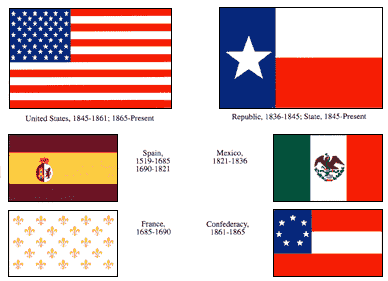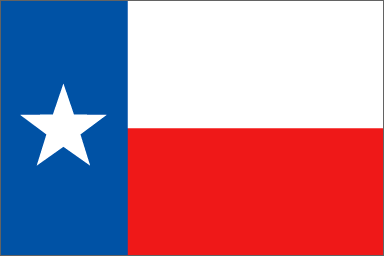|
|
The flag was adopted as the state flag when Texas became the 28th state in 1845. As with the flag of the United States, the blue stands for loyalty, the white represents strength, and the red is for bravery
The Texas Flag always flies high above Texas government buildings ~ just look around ~ It is everywhere ~ The star on the Texas Flag always reminds us that at one time we were our own country. It also reminds us that Texas got its nickname, The Lone Star State, from the five-pointed large white star that is on the side of the Texas Flag.

On Jan. 25, 1839, President
Mirabeau B. Lamar approved the adoption by Congress of a new national flag. This
flag consisted of "a blue perpendicular stripe of the width of one-third of the
whole length of the flag, with a white star of five points in the center
thereof, and two horizontal stripes of equal breadth, the upper stripe white,
the lower red, of the length of two-thirds of the whole flag." This is the Lone
Star Flag, which later became the state flag. Although Senator William H.
Wharton proposed the adoption of the Lone Star Flag in 1844, no one knows who
actually designed the flag. The legislature in 1879 inadvertently repealed the
law establishing the state flag, but the legislature adopted a new law in 1933
that legally re-established the flag's design.
The red, white and blue of the state flag stand respectively for bravery, purity and loyalty. Texas is one of only two states that has a flag that formerly served as the flag of an independent nation. The other is Hawaii.
Texas
A single star was part of the Long
Expedition (1819), Austin Colony (1821) and several flags of the early Republic
of Texas. Some say that the star represented the wish of many Texans to achieve
statehood in the United States. Others say it originally represented Texas as
the lone state of Mexico which was attempting to uphold its rights under the
Mexican Constitution of 1824. At least one "lone star" flag was flown during the
Battle of Concepcion and the Siege of Bexar (1835). Joanna Troutman's flag with
a single blue star was raised over Velasco on January 8, 1836. Another flag with
a single star was raised at the Alamo (1836) according to a journal entry by
David Crockett. One carried by General Sam Houston's Texan army (which defeated
Mexican General Santa Anna at the Battle of San Jacinto ) may have been captured
and taken to Mexico. Another "lone star" flag, similar to the current one but
with the red stripe above the white, was also captured the following year (1837)
and returned to Mexico. The "David G. Burnet" flag, of "an azure ground" (blue
background) "with a large golden star central" was adopted by the Congress of
the Republic of Texas in December of 1836. It continued in use as a battle flag
after being superseded in January of 1839. The 1839 design has been used to
symbolize the Republic and the “Lone Star State” ever since.
source: http://www.main.org/boyscout/texas.htm
Pledge to the Texas Flag
"Honor
the Texas flag;
I pledge allegiance to thee,
Texas, one and indivisible."
Six Flags of
Texas
Six different flags have
flown over Texas during eight changes of sovereignty. The accepted sequence of
these flags follows:
Spanish - 1519-1685.
French - 1685-1690.
Spanish - 1690-1821.
Mexican - 1821-1836.
Republic of Texas - 1836-1845.
United States - 1845-1861.
Confederate States of America - 1861-1865.
United States - 1865 to the present.
THE LAW
REGARDING ~THE FLAG~
AND The Other Texas Symbols
LONG ~ but some interesting reading.
SIX FLAGS OVER TEXAS. Six Flags over Texas, a tourist attraction, is located equidistant between Dallas and Fort Worth in Arlington just off Interstate Highway 30 and State Highway 360. The amusement park is owned and operated by the Great Southwest Corporation. It was one of the first theme entertainment centers in the United States when it opened on August 5, 1961. Replicas of historic places on the grounds depict the history of the Lone Star State. The six flags are those that have flown over Texas: the flags of Spain, France, Mexico, the Republic of Texas,qv the Confederate States of America, and the United States of America. The Texas Historical Commissionqv placed Texas historical markers at a replica of Fort St. Louis,qv originally established in 1685; a "Boom Town" that contains some of the oil rigging and tools used by roughnecks during the 1920s; an antique hand-carved carousel; and at the park's demonstration of Texas railroads, which provides visitors a view of some of the original narrow-gauge railway tracks used in the nineteenth century. The 205-acre park, constructed at a total cost of $10 million, offers more than 100 rides and shows for the price of admission. Popular recording artists perform at the Music Mill Theater during the evenings. An amphitheater provides revues, and a number of restaurants serve traditional Southern, Mexican, and American foods. Rides include a runaway train, a 143-foot-tall wooden rollercoaster, a log-flume water ride, and the "Cliff-hanger," which provides the sensation of stepping off a nine-story building and free-falling for 155 feet. In its first thirty years of operation, Six Flags over Texas had forty million visitors. The park is open on weekends from March through May, daily from June through Labor Day, and on weekends through early November. Between Thanksgiving and New Year's Eve the park hosts a festival called Holiday in the Park.
BIBLIOGRAPHY: Texas (Austin: Texas Monthly Press, 1982; rev. ed., 1989).
From various sites on the web ~ The first flag is from ~ Lone Star Junction, Texas Almanac ~
